Buying a new Jimny in Australia
This article is really designed to help dispell some various bits of misinformation and hopefully help people navigate buying a Jimny.
One small thing to note: Suzuki Australia services everywhere but Queensland and super northern NSW. Suzuki Queensland is a separate importer, although to date they have brought in the same specification cars. Wait time varies between the two importers. Warranty is compatible across jurisdictions but to avoid potential headaches you may wish to consider buying from the appropriate importer.
Sections
- Options and specifications
- Pricing
- Wait times
- Accessories at the dealership or elsewhere?
- Pre-rego GVM upgrade?
- Sales figures for gen4
Options and specifications
(Current as of June 2024)
There are three specifications of Jimnys in Australia:
- 3 door lower specification (lite)
- 3 door higher specification (GLX)
- 5 door, one specification (XL)
All come with solid axles front and rear, the same suspension design, seat 4 people in differing levels of comfort, cruise control, collision avoidance assistance, front, side and seat airbags and the same K15B engine with either a 5 speed manual or 4 speed automatic gearbox. 3 doors are sourced from Japan, 5 doors from India. Front seats are the same across all models, 5 door cars have different rear seats to all 3 doors.
Key differences (there are others!) are:
- Lite: manual only; halogen headlights; daytime running lights basic audio system with bluetooth
- GLX: automatic and manual options; LED headlights; infotainment system (currently 7″ Bosch unit with capacity for CarPlay/Android Auto and playing external media); colour matched door handles; fog lights
Note: As of mid 2024, it appears that the Bosch 7″ unit no longer ships with inbuilt GPS navigation, which it did prior to this time - XL: longer wheel base and 2 extra doors, larger boot (but the seats fold differently), adaptive cruise control (automatic), 9″ infotainment system (without inbuilt GPS, but CarPlay/Android Auto compatible)
Colours
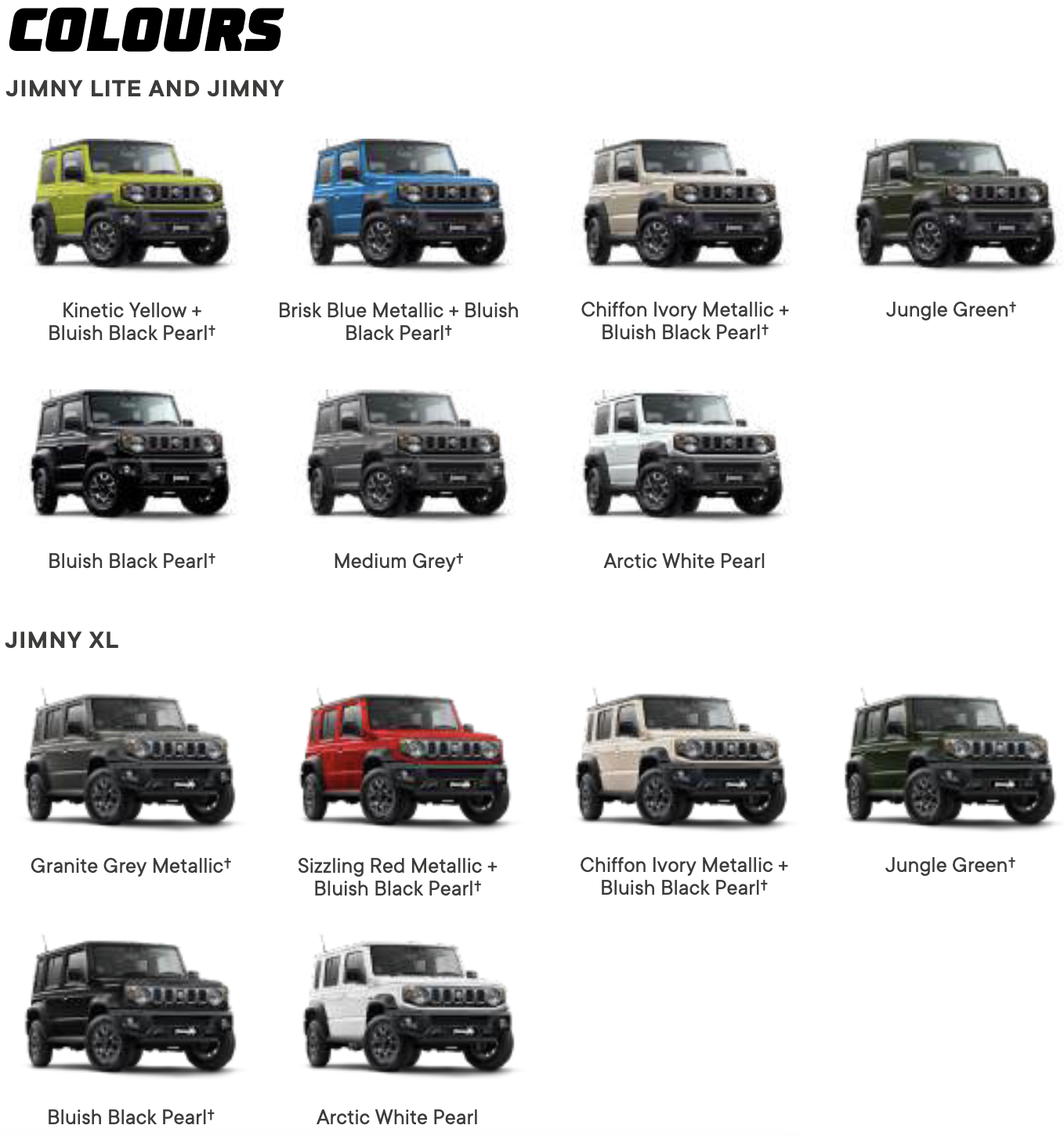
I go through the Jimny colour codes here, but some key differences:
- Red is only available in the 5 door XL model
- Kinetic yellow and blue only available in 3 door models
- Greys are different between 3 and 5 door models
Pricing
New pricing announced mid July 2024 has the Jimny as a driveaway price in Australia (except Queensland and far northern NSW):
- Lite: $34,990
- 3 door manual: $36,490
- 3 door automatic: $38,990
- 5 door manual: $39,490
- 5 door automatic: $41,990
This includes all driveaway costs including dealer delivery, registration and stamp duty. The below stuff is left in place to help either people in Queensland still understand the pricing, but also as it helps break down where the pricing comes from in the above driveaway pricing.
(Older pricing, June 2024)
The best stab I can have at the recommended retail price before dealer delivery, registration and stamp duty costs is:
- Lite: $30,640
- 3 door manual: $32,140
- 3 door automatic: $34,490
- 5 door manual: $35,140
- 5 door automatic: $37,490
There are costs for premium paint. Based on the most recent info I’ve received from a couple of dealers this seems to be $690 for a single tone colour that isn’t white, and $1280 for two-tone colours i.e. roof black instead of body colour.
The driveaway price, however, will be a reasonable amount more than this base price + paint cost. Driveaway pricing is base price + dealer delivery + stamp duty + registration costs + any accessories you get fitted at the dealership.
Dealer delivery to date has ranged from ~$1000 to $3000 for most people. As the economy has tightened into 2024 and demand has eased a little, $2000 seems more common than the higher or lower end of the spectrum. You can well get lucky either way, so it is worth chatting to a number of dealerships in your area to lock in the best overall price you can.
Stamp duty and registration costs per state vary, since they seem to be calculated prior to dealer delivery here’s my attempt to calculate it based on rates published in the middle of 2024. NSW rego costs do not include 3rd party insurance because that varies too much; other states if there’s a choice I picked the highest option. Rego is also for 12 month period, and includes all establish rego fees like new plates etc. I might be off on some of these fees so this price is indicative and people should research their own prices.
Note that last point: these registration fees include establishing rego, so your yearly renewal is likely lower than shown here.
| Qld | NSW | ACT | Victoria | Tasmania | SA | WA | NT | |
|---|---|---|---|---|---|---|---|---|
| Stamp duty low (on $30,490) | $921.00 | $921.00 | $307.00 | $1293.60 | $921.00 | $1168.00 | $1103.00 | $921.00 |
| Stamp duty high (on $37,490) | $1125.00 | $1125.00 | $375.00 | $1579.20 | $1325.00 | $1440.00 | $1732.00 | $1125.00 |
| 3 door rego inc. new plate | $827.00 | $489 + 3rd party insurance | $1030.60 | $917.70 | $623.62 | $670.00 | $822.12 | $837.25 |
| 5 door rego inc. new plate | $827.00 | $489 + 3rd party insuranc | $1030.60 | $917.70 | $623.62 | $670.00 | $848.64 | $837.25 |
ACT stamp duty: calculated based on emissions performance class B (131 – 175 g CO2/km) based on combined emissions of JB74; JC74 might come in as ‘unrated’ in which case it will cost more!
Victorian registration calculated on most expensive option (Melbourne & surrounds); SA on metro fees not country fees. WA does rego on tare weight so JC74 > JB74.
There are potentially some bulk fees if charged by a dealership, inspection fees for some jursidictions and stuff that I haven’t accounted for, but that should cover the bulk of the on-road costs.
To calculate the pricing:
Total price = base price + paint + accessories + stamp duty + rego fees + dealer delivery.
Practically, the dealer delivery is the main differentiator in pricing: for the same car with the same paint and accessories, really it’s down to however much a dealership charges in delivery fees as to what you pay. This is why it pays to shop around to at least all the dealers local to you as that dealer delivery fee will be what matters. You just want to do the shopping on the out the door, on the road registered cost all done and dusted.
As an example, buying an auto 3 door, in ivory + black roof ($34,490 + $1280 = $36,870 for duty), in WA at the present day, probably getting charged $2000 dealer delivery, and no other accessories comes out at:
Total price = $36,870 (car plus two-tone paint) + $1670.20 (duty) + $2000 (dealer delivery) + $822.12 (12 month rego + establish)
Total driveaway price for this example = $41,362.32 on the road
Historic pricing trends
I’ve tried to keep a track of historic pricing. Sometimes this hasn’t been super easy, and things like recent price rises were announced in a slightly opaque way so there might be a few hundred $ here or there in some cases.
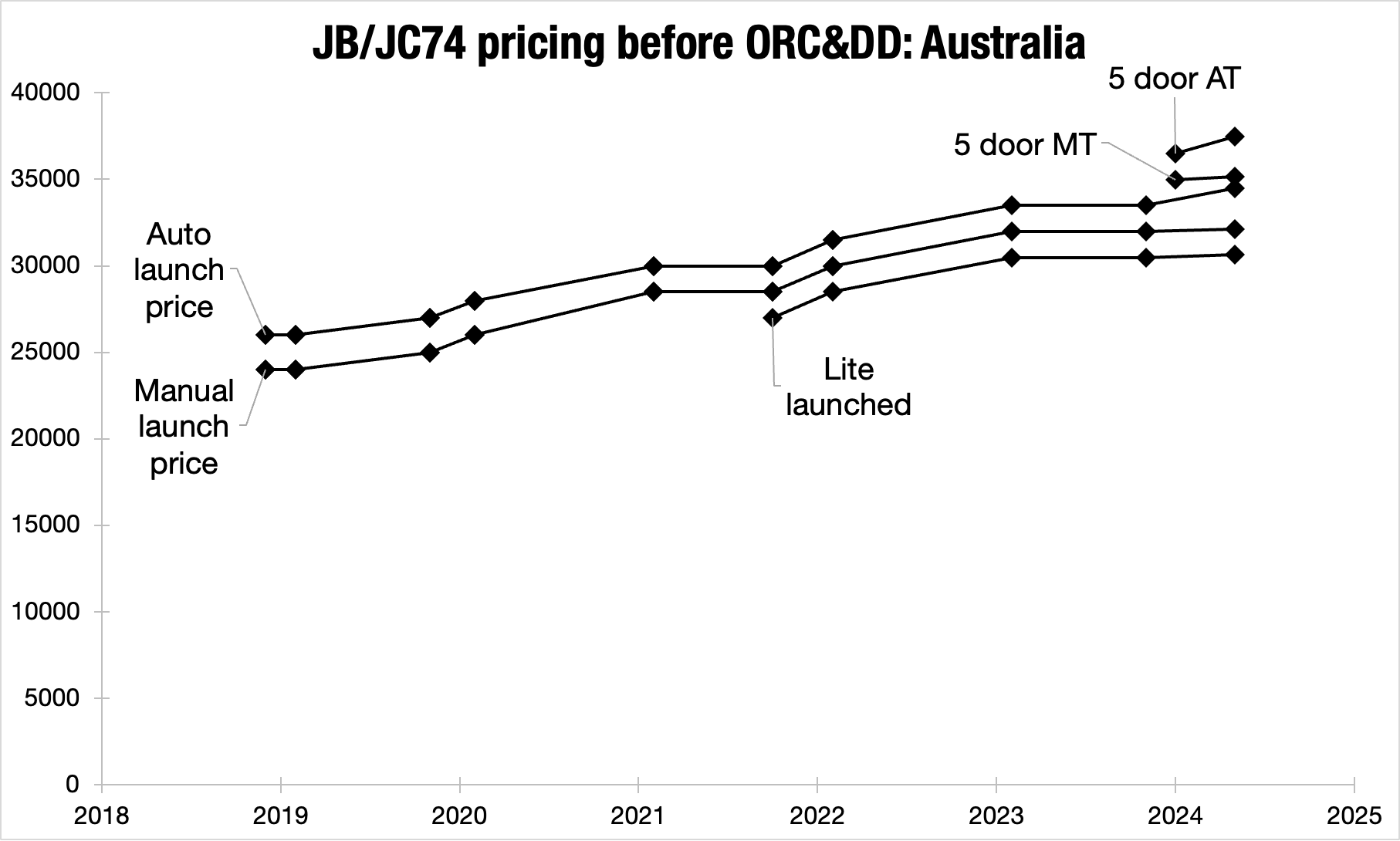
Note that these prices are before premium paint, dealer delivery and all on-road costs, and are based on the best publicly available data I have to hand. Also despite the lines showing gradients, the prices at a set point in time apply until the new pricing is hit (but that’s hard to depict easily).
Wait times
This one is really, really hard to say with any certainty. Most people wait 3-6 months, although up to 12 months is possible for particular colours. Some people have waited even longer than that.
There are some trends:
- 5 door wait time is less than 3 door wait times
There is more capacity out of India than out of Japan, hence the shorter wait times on 5 doors. - Manual wait times are shorter than automatics, by up to 3x.
Automatic 3 doors still can have a wait period up to a year; manuals (especially lites) are almost becoming available directly from car yard stock or at least next shipment (~3-6 weeks). - Different colours will have different wait times, and they are not consistent over time.
White is produced the most, and blue the least, but sometimes there’s just a big production run of one colour and heaps of people get that car, and then waiting for ages for the next run.
Dealerships do not get a heap of visibility of incoming cars. Jimnys are not built to order, so you will not get an allocated VIN until the car is basically unloaded at the docks in Australia. They bulk build, they’re exported from either Japan or Australia, and then get allocated to dealerships once they arrive at a port.
There is a national-level queue maintained to try to keep things fair, but, sometimes things just don’t work out and dealerships in one area get stock before another. There can also be limited warning before your car turns up, so you can wait a long time with little information (as dealers don’t know anything more than you, they’ll just be guessing) and then your car is here!
Accessories at the dealership or elsewhere?
This is a commonly asked question. There are a huge range of factory accessories, but not everything is available as a factory accessory e.g. aftermarket suspension lifts are not ‘factory accessories’.
On top of the factory accessories, there are other options that dealerships might offer. Common ones include
- Window tinting
- Paint protection
- Dash cameras
- Extended warranties over and above the factory warranty
A good reason to get accessories done, factory or otherwise, at the dealership is they can give you one combined price. If you are leasing the vehicle or financing it then this can be attractive as it makes for one single payment amount to be resolved between the financial institute or lease company of your choosing and the dealership.
Many of the accessories offered by dealerships outside of the factory accessories are huge profit centres for the dealership. E.g. they likely outsource the window tinting and paint protection to a separate provider and charge significantly more for it. The question then becomes worth it to you to have it resolved there and then.
It can be worth shopping around for a window tinting quote outside of the dealership; paint protection is generally just something done by detailers (e.g. ceramic coating) and doesn’t necessarily guarantee you protection against stone chips etc anyway. The extended warranties often also require you to stick with that particular dealership for your servicing; the factory warranty is valid so long as qualified mechanics using OEM parts or suitable equivalents perform routine maintenance so it can be a negative to have an extended warranty. Extended warranties also do not usually transfer to a new owner, but the balance of any factory warranty does.
For non factory accessories, some dealerships have good relationship with providers. As an example, some will have a local ARB store happy to fit whatever ARB accessories you have fitted. Bear in mind that this does not imply that the warranty will be 100% honoured by Suzuki: for stuff that is affected by modifications then you aren’t necessarily getting warranty through the factory for it, even if the dealership organised the fitment. Some dealerships will have you sign a waiver about warranty if you have non-genuine accessories fitted. (This doesn’t mean your warranty is entirely void, either: warranty is still preserved for stuff not affected by the accessories installed. You just can end up in annoying arguments over warranty for a heavily modified vehicle, however).
Personally, I don’t get accessories fitted by dealerships except where they’re factory accessories and potentially I’ve got a good deal on having them bundled with the car. Suspension lifts, different wheels, even audio system upgrades are usually best done outside of the dealership system.
Pre-rego GVM upgrade?
I’ve split this out into its own section purely as it gets asked so often!
Currently, the 3 door Jimnys have three options for a gross vehicle mass (GVM) upgrade done pre-registration, via the second-stage manufacturer process in Australia. They are as follows:
- Ironman: 1785 kg GVM, type approval # 50688
- Tough Dog: 1800 kg GVM, type approval # 61893
- TJM: 1800 kg GVM, type approval # 63560
As of writing (June 2024) none are yet listed in the Federal compliance database ROVER for the 5 door Jimny. All of the upgrades are a 40-50mm lift, and are relatively similar in spring rates and characteristics (essentially: pretty much the stiffer end of the spring rate range).
Having a GVM upgrade pre-registration is beneficial for a few reasons:
- The modification is valid in all states should you sell the vehicle or move states.
- The vehicle is ‘born’ lifted which can make certain subsequent modifications easier (some harder)
- It can be the cheapest way to have a GVM upgrade if you want one.
Let’s dive into those three segments a bit more to understand them.
A pre rego GVM upgrade is valid in all states as the vehicle is, effectively, manufactured as a different manufacturer rather than just Suzuki. Thus the compliance information all relates to the modified vehicle; if you do a GVM upgrade once the vehicle is registered then that is a state by state modification (a ‘mod plate’ if you will). A post rego upgraded car is still valid to be driven in other states, however, modifications certified in one state is not valid in another state if you actually re-register due to moving or you sell the car to someone else in a new state. They have to have the car certified and mod plated in that new state. A pre rego car has none of that, it just ‘is’ modified and treated like moving any other standard car between states registration systems.
The vehicle being born lifted can make some modifications easier. This is super state by state based; some states will take the new lifted height as the base height for assessing other modifications like wheel size changes. Other states take it as completely strict: the car is *only* valid with the pre-rego GVM if it conforms to all other requirements e.g. stock wheel and tyre size, absolutely zero modification to suspension components after it’s been upgraded.
A requirement to stay stock to preserve the pre-rego GVM upgrade can limit you if you want to run bigger wheels and tyres, or, you end up wanting to run different shock absorbers. You really need to speak to your individual State or Territory’s respective registration compliance body to understand how they interpret the regulations (and even then you might not get a straight answer).
Finally, the cost: a GVM upgrade for a Jimny basically is the same as a suspension lift with some expensive paperwork to explain why it can carry more weight. There’s no structural changes like different axle housings or anything. Like anything it’s good to minimise the cost.
A pre-rego cost usually doesn’t have to include a full engineering signoff since that’s covered by the second-stage manufacturer compliance paperwork. If you do the upgrade post rego, while the paperwork used is the same it is certified by an automotive engineer separately & that costs money (say $600-$900ish). Sometimes it also requires an additional roadworthy inspection (so maybe $50-$200). You save those costs pre-rego which is nice. There is a slight twist to that, though: stamp duty will apply to the pre-rego cost when it wouldn’t if you were doing it post registration. Since stamp duty is in the range of 3 to 5% then on a $3500 GVM upgrade then it really is only ~$100 to $200 sort of range added to the price of the car, however.
Is a GVM upgrade for you? That’s a much more complicated question and really comes down to how much gear you carry when camping or on a trip and what accessories you’ll add to your car. Even choices in things like bullbars can save you 20-30 kg off an equivalent option so there’s no one straightforward answer. If you have the choice and you are considering a GVM upgrade and you’re buying the car new then it really is worth considering doing it as a pre-rego upgrade, simply due to the savings and the potential assistance it’ll give you to resale for people outside of the state you’re in.
Sales figures for gen4
Gen4 Jimnys have sold pretty well, especially in comparison to generation 3 Jimnys. Just over 14,000 gen3 Jimnys were sold in the 20 years from 1998 to 2018; from start of 2019 to mid 2024 approximately 22,000 generation 4 Jimnys have been sold.
Note that these are delivered cars, not cars ordered.
Despite the price rises from the launch pricing to today, Jimnys have increased in popularity. The most popular months for sale have been after the launch of the 5 door, with around 5000 cars sold per year for the last few years.
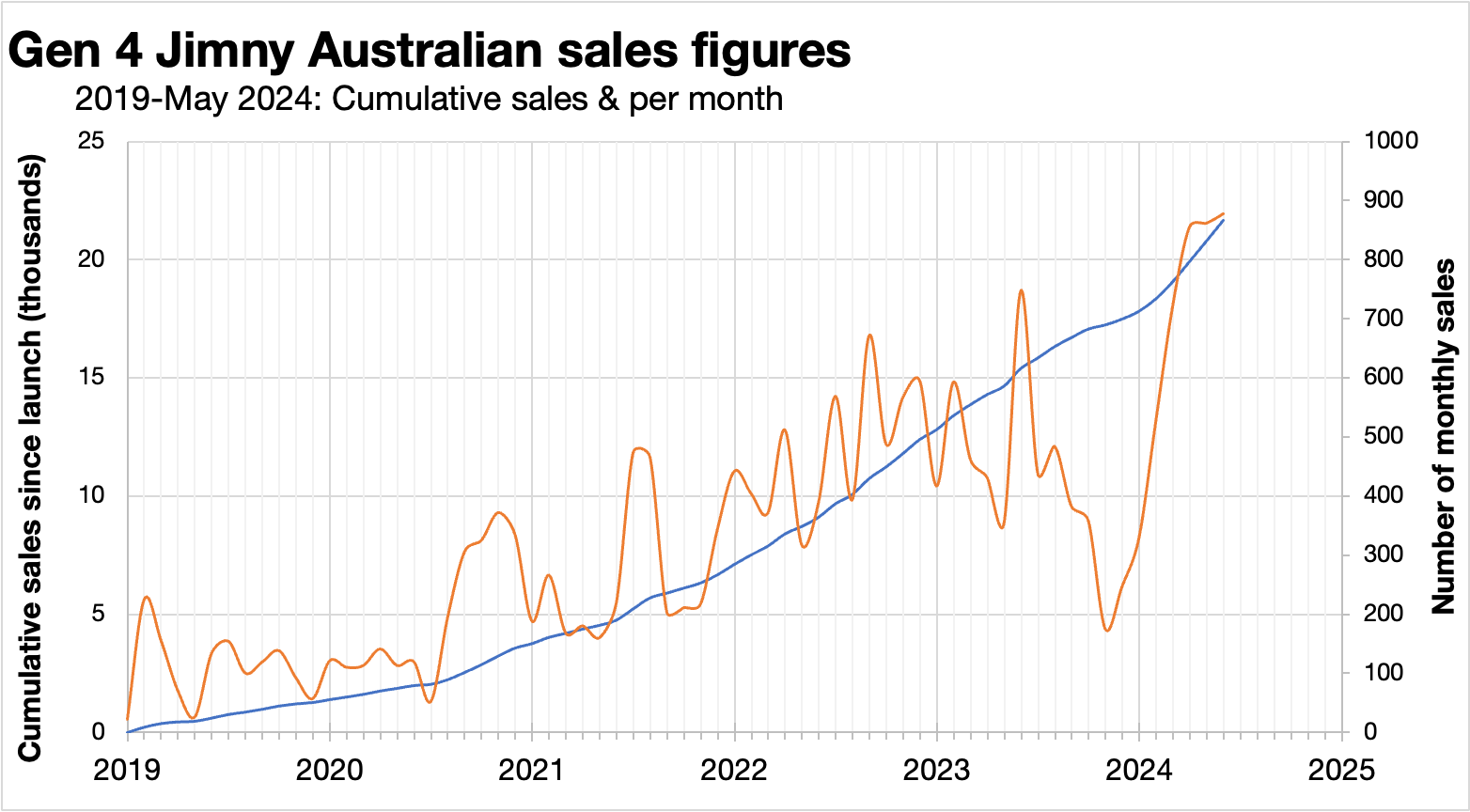
As a proportion of Suzuki sales, Jimnys have come to make up somewhere between a third and half of all Suzukis sold in Australia over the past few years.
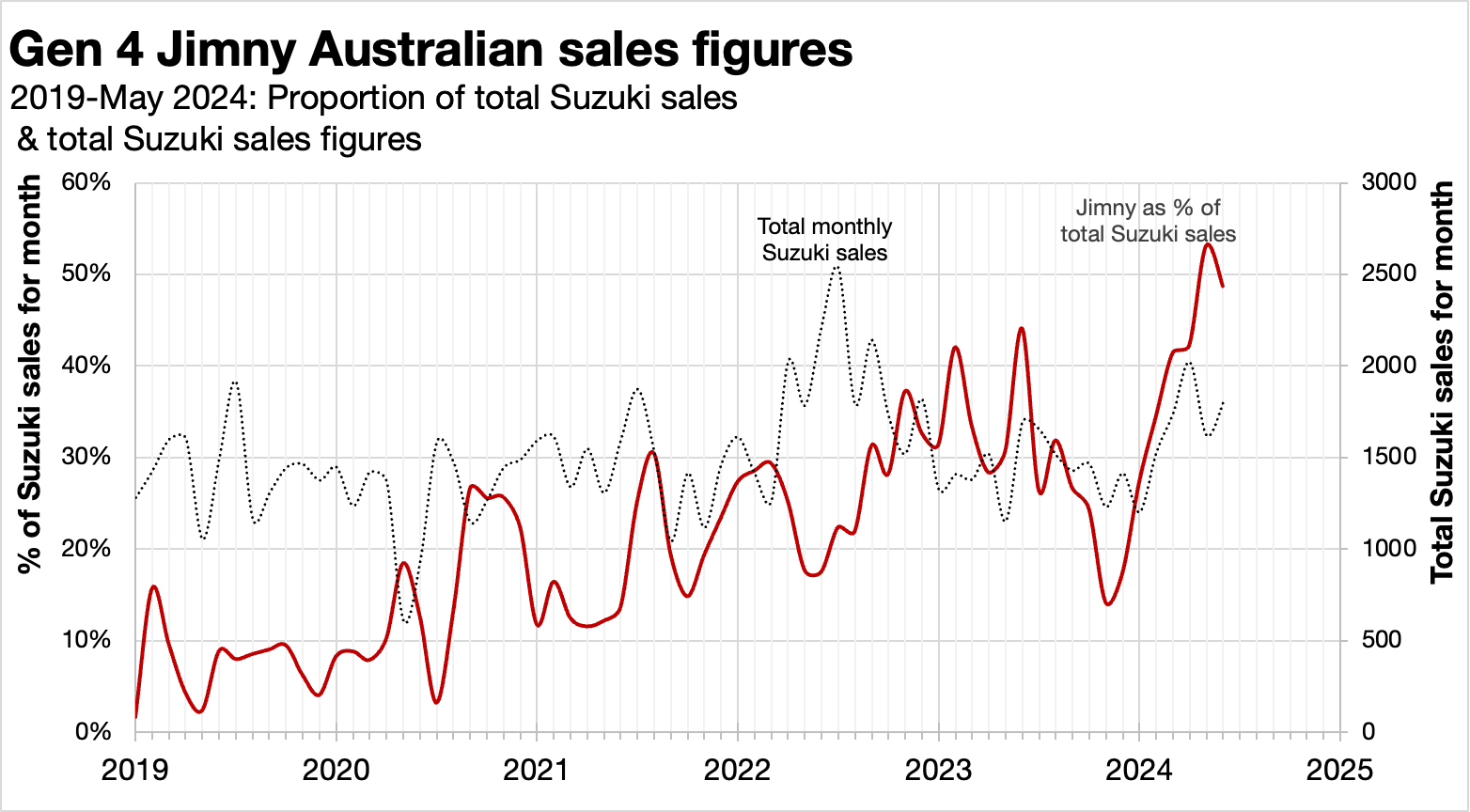
Car prices definitely haven’t dented the sales popularity, either. After overtaking the gen3 total sales numbers sometime in February 2023, gen4 sales have continued to grow.
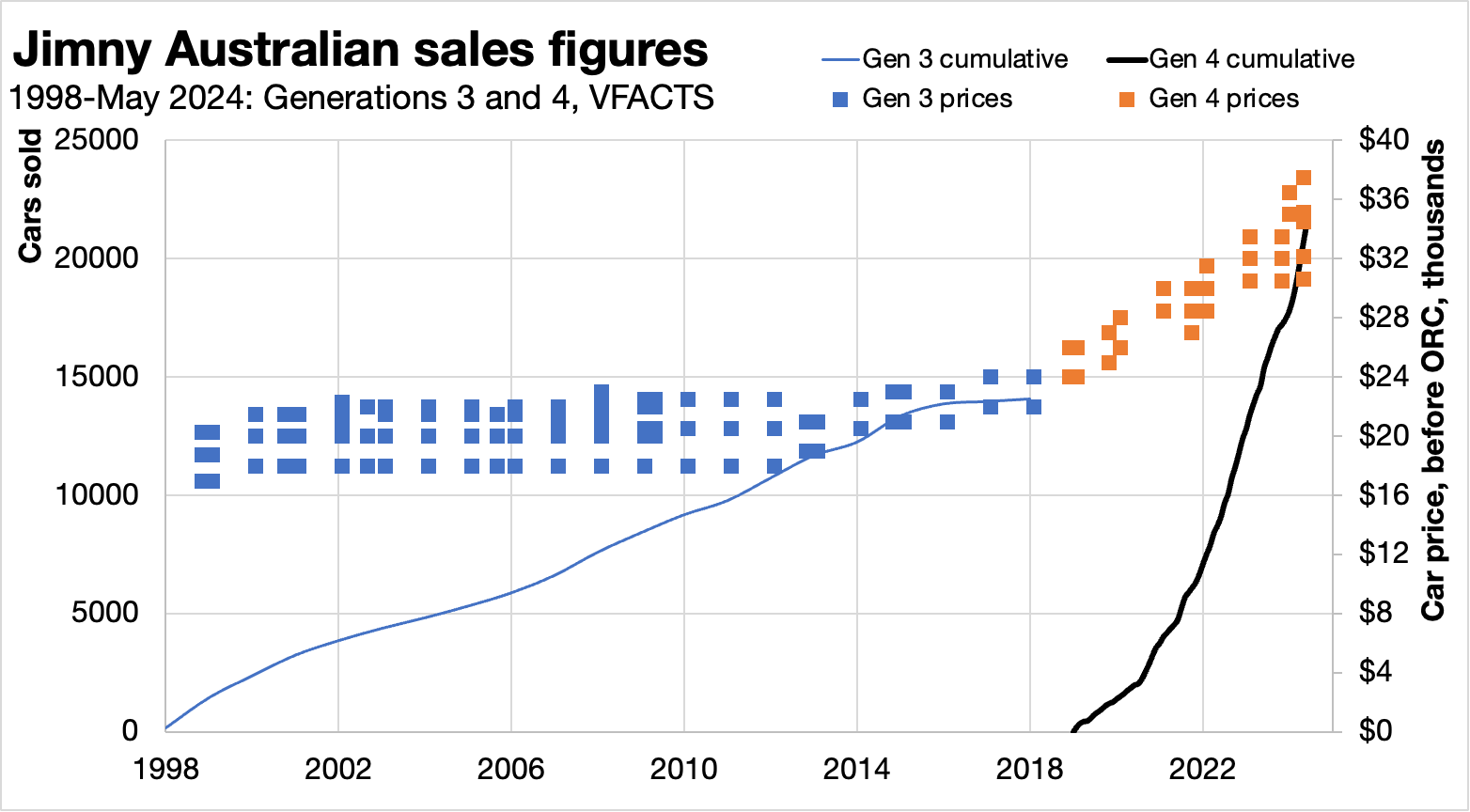
It remains to be seen how much longer this trend persists as economic conditions and drive towards higher fuel efficiency standards both point towards challenges, however, to date it’s been a very popular car for new car buyers.
That said, the increasing amount of new ones available and easing of second-hand pricing with the availability of cars increasing then it’s also potentially a time to consider buying a second-hand gen4 Jimny.
